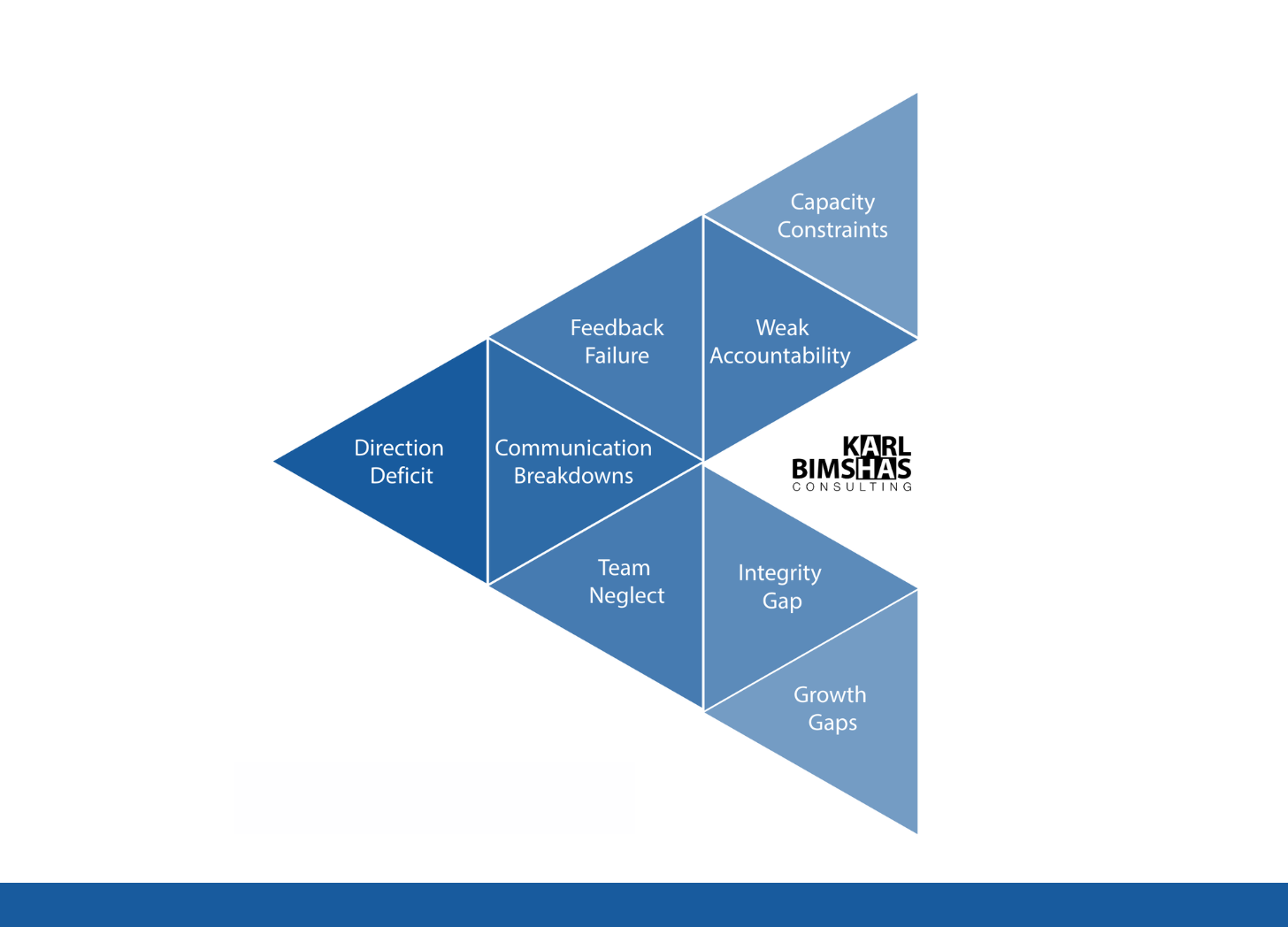You’ve felt it. The meetings that go nowhere. The leader who talks in circles. The slow drip of missed deadlines, low standards, and passive blame.
That’s not just bad management; that’s Leadership Drift. And it’s quietly wrecking the credibility, morale, and results of both leaders and organizations.
At Karl Bimshas Consulting, we don’t fix broken leaders; we replace broken systems. We’re building a principled leadership system rooted in clarity, accountability, and measurable progress.
The Leadership Guidance System™ (LGS) is our structured approach to defeating Leadership Drift and restoring integrity to leadership. Let’s walk through the pain points we address, promise real solutions, and outline the process that leads to lasting, principled leadership.
The Pain: Understanding Leadership Drift
Leadership has broken down or been abandoned, leading to what we call Leadership Drift. This drift is characterized by several critical failures that erode trust, stifle progress, and undermine organizational effectiveness.
- Direction Deficit: This drift occurs when an organization lacks a compelling vision and clear strategic direction, causing teams to lose sight of their purpose. Without defined goals and targets, focus deteriorates, and efforts become fragmented. A short-term focus often overshadows long-term objectives, and an overreliance on past successes prevents innovation and adaptability, leading to confusion and stagnation.
- Communication Breakdowns: This type of drift stems from poor or inconsistent communication, which significantly erodes trust and clarity within a team. Not sharing progress, successes, or challenges regularly causes confusion. Mixed messages or unpredictable actions from leaders further disrupt momentum, making it harder for team members to understand expectations and coordinate their efforts effectively.
- Feedback Failure: Leadership drift due to feedback failure occurs when monitoring performance and adapting to new information are neglected. This complacency allows minor issues to escalate into systemic problems. Ignoring external influences, such as market shifts or regulatory changes, disconnects strategy from reality. The absence of robust feedback loops and a lack of commitment to continuous improvement accelerate decline, preventing necessary course corrections.
- Team Neglect: This drift occurs when leaders overlook the voices, growth, and well-being of their team members, resulting in weakened morale and disengagement. Ignoring feedback and input makes team members feel undervalued, reducing their contributions. Unresolved conflicts fracture team cohesion, and a lack of diversity and inclusion can create blind spots. Ultimately, a disengaged team loses energy, ownership, and alignment with organizational goals.
- Weak Accountability: Drift thrives in environments where accountability is unclear or inconsistently enforced. Without clear responsibility, direction falters, and follow-through diminishes. Leaders who micromanage decisions stifle autonomy and growth, disempowering their teams. Ambiguity around roles and responsibilities further erodes commitment and makes it difficult to track progress, ultimately undermining execution.
- Integrity Gap: An integrity gap occurs when an organization’s stated values and its actual processes or behaviors are out of sync, fostering confusion and resistance. Unclear expectations and inconsistent processes hinder decisive action. Cultural misalignment, where real behavior contradicts stated values, breeds distrust. Allowing questionable practices to persist corrodes credibility and ensures operations fail to reflect what truly matters, compromising trust.
- Capacity Constraints: Even with strong leadership, drift can occur if the organizational infrastructure is unable to support effective execution. Inadequate resource allocation, including a lack of necessary tools, time, or support, directly hampers results. Silos hinder cross-functional collaboration, resulting in duplication and inefficiencies. Furthermore, resistance to change, characterized by inflexible systems and mindsets, blocks progress and adaptability, hindering the organization’s ability to move forward.
- Growth Gaps: Growth gaps emerge when personal and professional development stalls, and achievements go unrecognized, diminishing potential and motivation. When individual aspirations do not align with organizational goals, engagement tends to wane. A lack of training and development leads to stagnant skills, which in turn impair adaptability and innovation. Furthermore, the absence of celebration and recognition for achievements can reduce enthusiasm and create a sense of being undervalued.
The Promise: Restoring Principled Leadership
At Karl Bimshas Consulting, we promise to restore integrity to leadership and decisively end leadership drift. We equip professionals with the essential tools to hold themselves and others accountable, building a culture of high performance and unwavering integrity.
- Clarity, Command, and Control: These are the fundamental outcomes of our Leadership Guidance System™ (LGS). We help leaders to stop drifting and instead lead with integrity, even under the most intense pressure.
- Principled Leadership Systems: Our primary goal is to establish enduring systems founded on clarity, accountability, and uncompromising standards. We don’t rely on fleeting tips or cheerleading but on sustainable, principle-based frameworks.
- Anchor Integrity and Sharpen Impact: Our proprietary Canon of Standards™ is specifically designed to anchor your integrity, sharpen your impact, and eliminate excuse-making, providing a solid foundation for all leadership actions.
- Measurable Outcomes: The Effective Leadership Integrity Index™ (ELII) is our commitment to measuring what matters, namely, Clarity, Accountability, and Integrity. This provides a concrete way to diagnose weak spots, validate effective leadership, and replace personality-based leadership with principle-based action.
- A Roadmap for Transformation: The ELII is not a report card, but a clear roadmap that guides leaders in developing disciplined habits that consistently align their values with tangible results.
We believe this is more than a program; it’s a movement for serious professionals who are wired to fix what’s broken and are committed to rebuilding systems with higher, more rigorous standards.
The Process: The Leadership Guidance System™
Our solution, the Leadership Guidance System™ (LGS), integrates several core components to provide comprehensive guidance for leaders. It helps answer three critical questions: Where are you going, where are you right now, and what are you doing about it?
The Canon of Standards™: The Heart of the System
This is the backbone of our system, representing the non-negotiable standards of principled leadership. It comprises seven core standards, each with a Doctrine (the underlying principle), Discipline (how to implement it), and Auditable Standards (how it’s Observable, Trainable, and Enforceable). For a detailed view, visit https://www.karlbimshasconsulting.com/the-canon/
- Know Yourself and Your Purpose: Purpose is a prerequisite for leadership; self-awareness is the ignition switch. Without clarity, you’re loitering.
- Model Relentless Accountability: Leadership is ownership, not lip service. Leaders must hold themselves to the highest standard before demanding it from others.
- Develop and Protect Standards: Leaders shape culture by defining and enforcing what’s acceptable and essential. Standards are foundational, not situational.
- Act with Integrity and Courage: Courageous leadership is calm under pressure; integrity is a daily choice. Leaders remain steady and don’t flinch when it’s uncomfortable.
- Decide Decisively: Indecision is a form of leadership drift. Decisive leaders deliver, choose direction, own it, and adjust quickly.
- Communicate with Precision: Vagueness is weakness. Clear communication creates alignment; fuzzy communication indicates failed leadership and undermines trust.
- Drive Progress Relentlessly: Leadership is motion with meaning, focused on building people, systems, and momentum. Leaders design movement and remove friction.
The Effective Leadership Integrity Index™ (ELII): Measure What Matters
The ELII is our proprietary framework that measures 15 high-impact behavioral KPIs across self-leadership, one-on-one leadership, team leadership, organizational leadership, and governance. Every Key Performance Indicator within the Index is designed to reflect reality, expose drift, and directly connect to both the LGS and the Canon of Standards. This provides a tactical, data-driven approach to building and reinforcing disciplined leadership habits. Examples include Emotional Afterburn for self-regulation, Command Clarity for precise communication, and Decision Speed Index for timely action.
Implementing the LGS: Your Three-Step Process
Our LGS guides leaders through a clear, actionable process:
- Step 1: Reconnect to Purpose: We help leaders review their leadership mission and values, using the Canon of Standards™ as their compass. This aligns with the Guidance component of the LGS, which focuses on vision, values, and strategic priorities to achieve ultimate clarity.
- Step 2: Assess Your Drift: We facilitate leaders in taking the Effective Leadership Integrity Index™ (ELII) to pinpoint exactly where clarity, credibility, or momentum have been lost. This relates to the Navigation component, which involves self-awareness, team dynamics, and leveraging the ELII to build unwavering confidence.
- Step 3: Build Better Systems: We then focus on helping leaders to make better decisions and do so more efficiently. This aligns with the Control component of the LGS, emphasizing robust accountability, effective feedback loops, and decisive action.
Together, these integrated components form a comprehensive system for leaders to effectively address their most pressing challenges, commit to demonstrably higher standards, and consistently drive principled progress within their organizations.
We are building this publicly (Why Building in Public Is Part of the System), so check back often to grab the tools, assessments, and philosophy you need to battle Leadership Drift in your organization.
If you’re tired of tolerating weak leadership systems, it’s time to install one that works. Start with the ELII. Explore the Canon. Stop leadership drift — for good.



